 Did she or didn’t she?  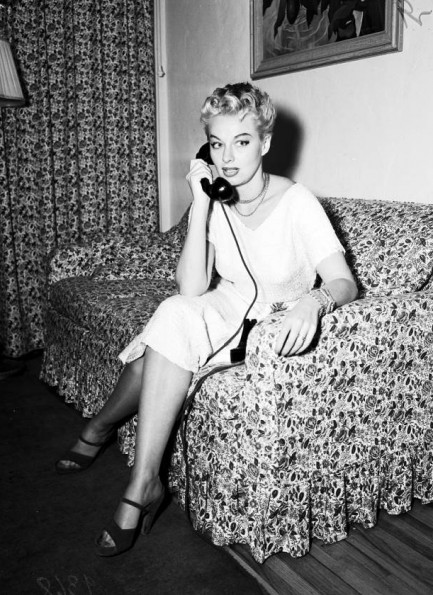
These two photos showing burlesque dancer Lili St. Cyr were shot today in 1951 for a Los Angeles Examiner story about St. Cyr’s legal difficulties. On 23 February of that year she had begun performing at Ciro’s supper club in Hollywood. It was a different type of club for her—it lacked the intimacy of her normal venues, and would sap some of the heat from her act, but the place was world famous and considered by the smart set to be classy. It had hosted Edith Piaf, Marlene Dietrich, Duke Ellington, and Dinah Washington. Of late it was facing stiff competition from Macambo’s, a Brazilian themed joint across the street, and owner Herman Hover wanted to make a splash with St. Cyr. He spent thousands refurbishing the stage just for her, and she would be the first burlesque dancer to transition from men’s clubs to L.A.’s most famous supper club. On premiere night celebs such as Ronald Reagan, Nancy Davis, Franchot Tone, Barbara Payton, Lex Barker, Mickey Rooney, and Los Angeles mayor Fletcher Bowron watched her strip down to toned perfection as they ate dinner and sipped drinks. Other celebs that visited that summer included Bette Davis, Humphrey Bogart, and Clark Gable. During St. Cyr’s residency she varied her act, but a standard bit was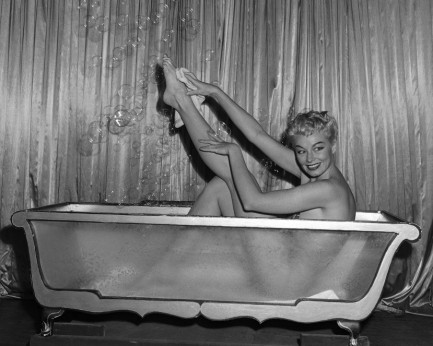 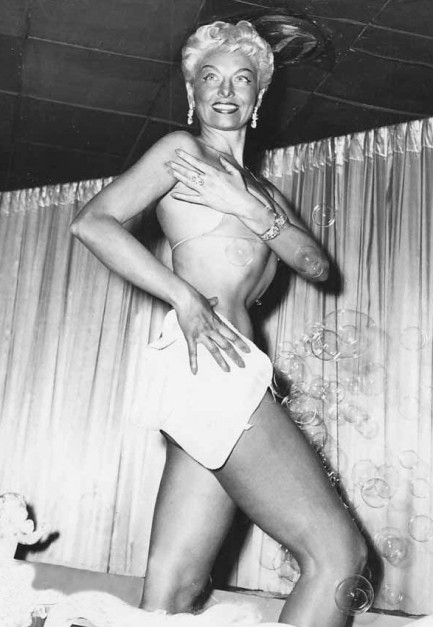 entitled "An Interlude Before Evening," and involved being helped from her clothing by her maid Sadie before slipping nude into a bathtub. But the nudity was an illusion, the cleverest part of her act, achieved through a combination of lighting, positioning, flesh-colored underwear, and sheer athleticism as she slipped quickly from behind a towel and into the sudsy tub. entitled "An Interlude Before Evening," and involved being helped from her clothing by her maid Sadie before slipping nude into a bathtub. But the nudity was an illusion, the cleverest part of her act, achieved through a combination of lighting, positioning, flesh-colored underwear, and sheer athleticism as she slipped quickly from behind a towel and into the sudsy tub. On 18 October a group of Los Angeles sheriff’s deputies, who were trying to enforce a countywide ban against stripping, arrested St. Cyr and Herman Hover. The charges were the usual slate. St. Cyr called upon celebrity lawyer Jerry Giesler—an event the two Examiner photos at top are supposed to be illustrating—and Giesler proceeded to help turn what was already a media boon for St. Cyr into a full bonanza. Giesler was a showman, and he loved cases that had the potential to increase his fame. He made assorted sensational statements to the press, including one in which he promised to have his client perform her bath routine in the courtroom, and another in which he opined that putting together a jury of peers required empaneling a dozen strippers. He described St. Cyr as merely trying to improve her station in life, just an industrious woman trying to carve herself a piece of American pie. The press ate it up. 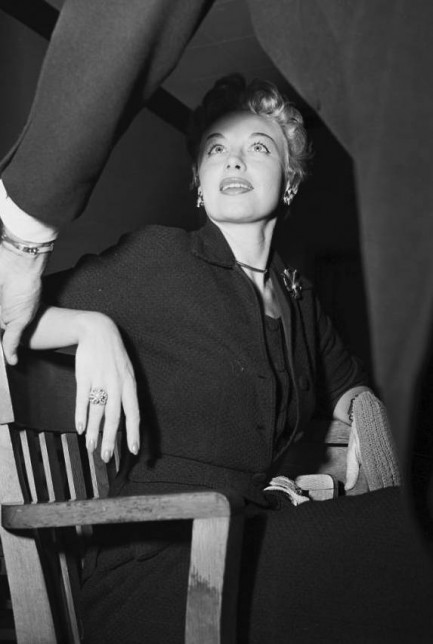 The trial was scheduled for early December in the Beverly Hills Courthouse. Giesler kept the jury—which wasn’t all strippers, but at least was mostly female—laughing with his continual antics. He introduced St. Cyr’s rhinestone encrusted bra and g-string as people’s exhibits A and B. He drew diagrams on a blackboard illustrating how different observers' vantage points toward the stage were blocked by St. Cyr's maid. He flustered police officials by making them discuss in detail such such terms as “bump,” “grind,” and “half-bump,” and followed that up by putting Herman Hover on the witness stand and having him demonstrate those moves. The sight of the portly Hover attempting burlesque sent ripples of laughter through the courtroom. Years later Giesler wrote: “I can honestly say I succeeded in having her case laughed into a not-guilty verdict.” The trial was scheduled for early December in the Beverly Hills Courthouse. Giesler kept the jury—which wasn’t all strippers, but at least was mostly female—laughing with his continual antics. He introduced St. Cyr’s rhinestone encrusted bra and g-string as people’s exhibits A and B. He drew diagrams on a blackboard illustrating how different observers' vantage points toward the stage were blocked by St. Cyr's maid. He flustered police officials by making them discuss in detail such such terms as “bump,” “grind,” and “half-bump,” and followed that up by putting Herman Hover on the witness stand and having him demonstrate those moves. The sight of the portly Hover attempting burlesque sent ripples of laughter through the courtroom. Years later Giesler wrote: “I can honestly say I succeeded in having her case laughed into a not-guilty verdict.” That may have been true, but St Cyr’s icy demeanor was also an important factor. The women found her elegant and remote—the opposite of what they had expected. And the cops did their part for St. Cyr's defense by being terrible witnesses. One claimed that she emerged from the tub completely nude (the normal conclusion to her Interlude, and just as illusory). Another said she wore undies but that he could 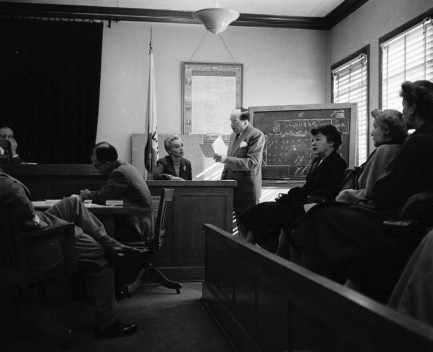 see the outline of her “private parts,” which he discerned in enough detail to determine “were shaven.” The inconsistencies were epic. Some said she caressed herself, others weren’t sure. Another described her towel as “about twenty, twenty-four inches.” In reality it was three times that size. It was as if St. Cyr's dance had dumbfounded the cops. see the outline of her “private parts,” which he discerned in enough detail to determine “were shaven.” The inconsistencies were epic. Some said she caressed herself, others weren’t sure. Another described her towel as “about twenty, twenty-four inches.” In reality it was three times that size. It was as if St. Cyr's dance had dumbfounded the cops. The confusion has extended even to the present day. For a performance that lasted barely fifteen minutes, it has had an amazing amount of conflicting information attached to it. Columnist Army Archerd claimed St. Cyr was indeed nude that night (clearly wrong, according to multiple testimonies); Sheila Weller’s book Dancing at Ciro’s claims an “all-male” jury (it was mostly female) was taken to Ciro’s to see the act (Giesler tried, but the judge said no); some sources claim St. Cyr performed a reverse strip, beginning nude in the tub and emerging to be slowly dressed by her maid (indeed, that was an oft-performed variation, so it is certainly possible it happened that night). Who's right, and who's wrong? Short of using a time machine to return to October 1951 there's no way to tell. At the end of the six-day trial the jury acquitted St. Cyr following a mere seventy-eight minutes of deliberations. There had been no indecent exposure. At least not that night. All St. Cyr’s biographers agree on this much—she was shy and regal offstage, but her performances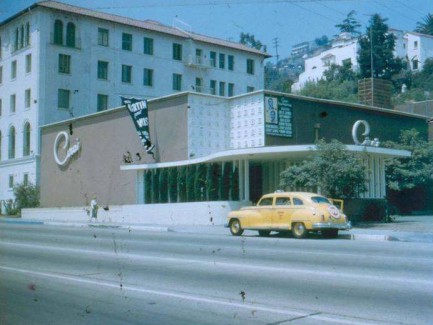  freed her to inhabit different characters. Despite her assertions that she always wore at least a g-string and bra, she definitely performed topless on occasion, as shown by the above photo taken at Ciro’s during early 1951. freed her to inhabit different characters. Despite her assertions that she always wore at least a g-string and bra, she definitely performed topless on occasion, as shown by the above photo taken at Ciro’s during early 1951. Sheriff’s deputies had gone to the club already intent upon arresting her based on what they had heard about the act, which may have influenced their testimony—i.e., they didn’t see her nude, but knew she had done it before. St. Cyr admitted in court she knew police were in the audience, thus she was especially careful that night. But what of other nights? Maybe Army Archerd did what columnists do—took an event he witnessed on one night and pretended it happened on a more useful one. Maybe St. Cyr, on occasions when she knew the cops were far away, flashed her audience to generate buzz. It’s likely we’ll never know what really happened, but that merely adds to the St. Cyr mystique. Did she or didn’t she? Only her maid knew for sure.
 Everybody who was anybody was there. 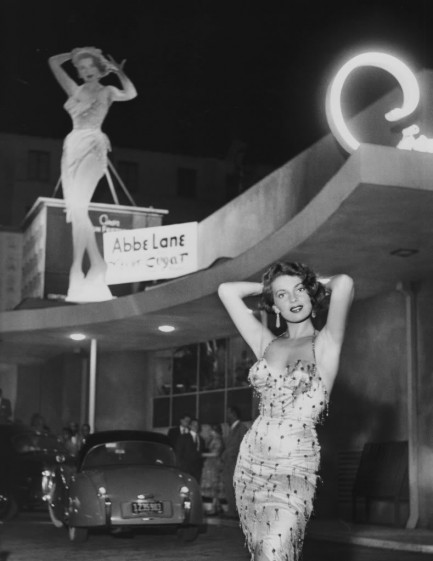
This photo made today in 1954 shows American singer/actress Abbe Lane posing outside Ciro’s nightclub in West Hollywood, California. Lane had begun in show business as a child actress, but became world famous after she married bandleader Xavier Cugat and began fronting his group as a singer. Although this is a famous photo, one you can find elsewhere on the internet, we thought it was worth posting anyway, not just because of Lane, but because supper clubs like Ciro’s really don’t exist anymore. Ciro’s, which by the way was unrelated to the many famous Ciro’s that existed in Europe during the Jazz Age, from its opening in 1940 to its closing in 1957 was a favorite spot of screen personalities, singers, producers, and writers, a place where the night’s meet-ups and trysts were reported in the next day’s gossip columns. Below you see Lane and Cugat, Charlie Chaplin with Paulette Goddard, Lane onstage fronting Cugat’s rumba band, Cary Grant with Betsy Drake, Lucille Ball with Desi Arnaz, Jr., and others.
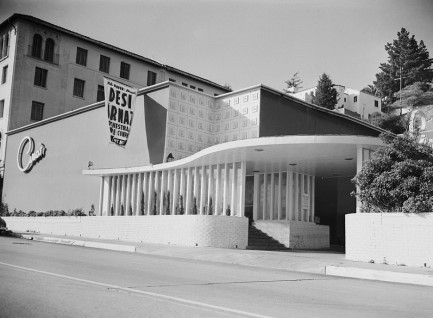 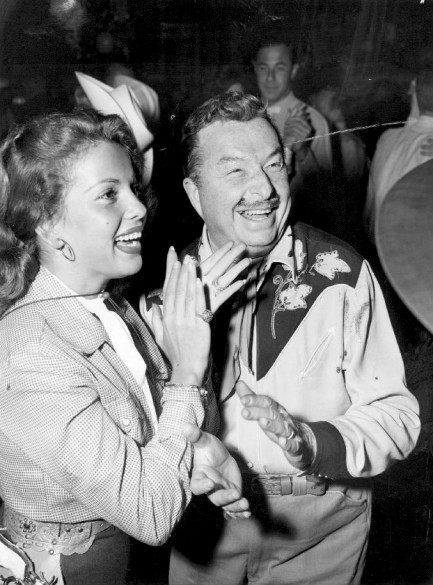 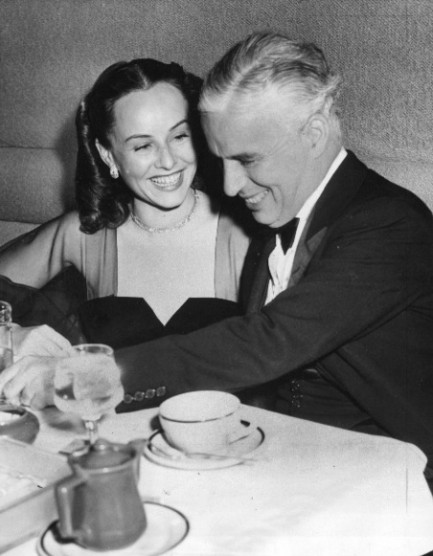 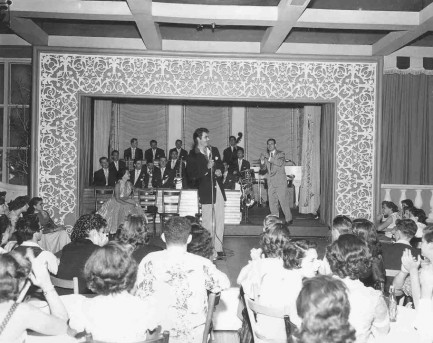 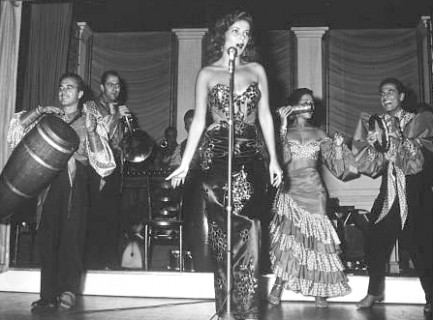 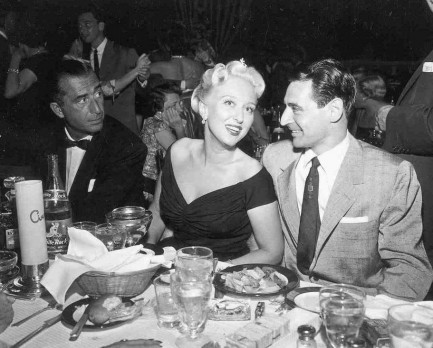 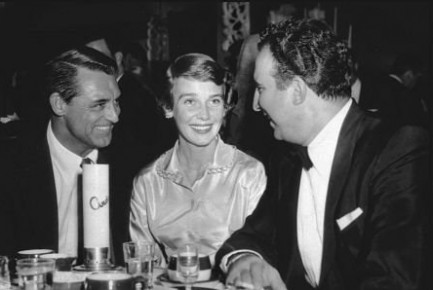 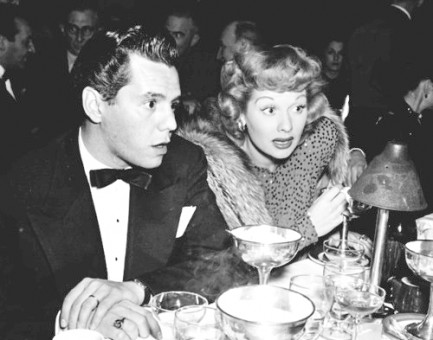 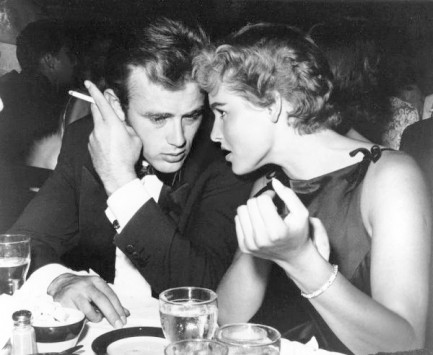 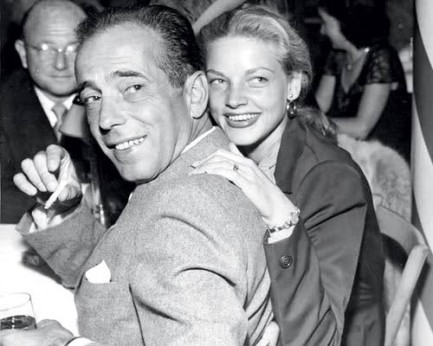
 Exposed arrives on the scene late, never quite gets up to speed. 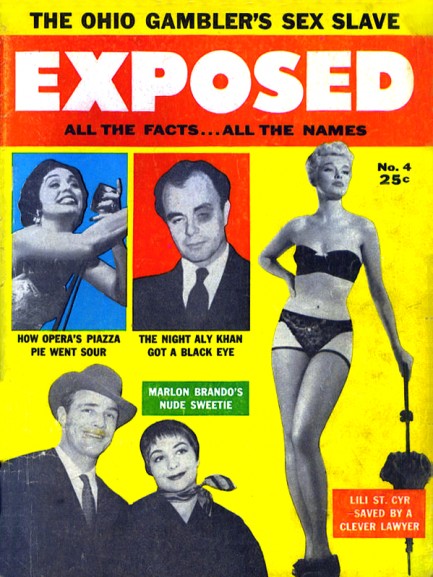
Tabloid month continues with the New York City-based Exposed, one of the middle tier entrants onto the scandal sheet scene. The magazine came on the scene a bit later than the heavyweights, at a time when the tabloid market was already packed with better-produced, better-funded rivals. Little wonder then, that Exposed folded quickly—we’ve seen issues numbering up to 18 but no further. Inside this March 1956 issue, numbered 4, we have the usual victims—Brando, Lili St. Cyr, and Ali Khan. The clever lawyer mentioned here in connection with St. Cyr is Jerry Giesler. You see St. Cyr and Giesler hugging below, just after St. Cyr’s acquittal in Los Angeles from charges of indecent exposure at the nightclub Ciro’s. We talked about the trial a couple of years ago, but since then, the website Paradise Released has posted a more detailed version of that unusual day in court. We recommend giving it a read. And if you just can’t get enough, there’s another recent account at Pincurlmag, here, with some additional details. We’ll have more from Exposed, including some interior pages, a little later. 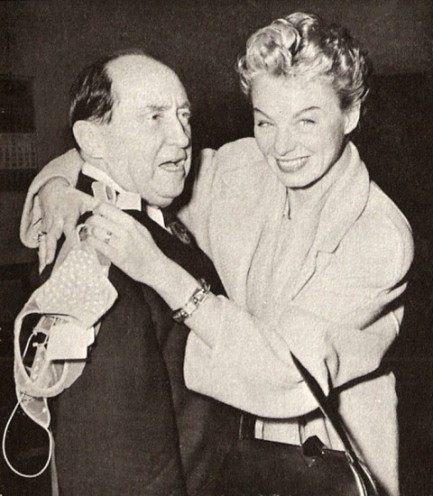
|
 |

The headlines that mattered yesteryear.
1947—Heyerdahl Embarks on Kon-Tiki
Norwegian ethnographer and adventurer Thor Heyerdahl and his five man crew set out from Peru on a giant balsa wood raft called the Kon-Tiki in order to prove that Peruvian natives could have settled Polynesia. After a 101 day, 4,300 mile (8,000 km) journey, Kon-Tiki smashes into the reef at Raroia in the Tuamotu Islands on August 7, 1947, thus demonstrating that it is possible for a primitive craft to survive a Pacific crossing. 1989—Soviets Acknowledge Chernobyl Accident
After two days of rumors and denials the Soviet Union admits there was an accident at the Chernobyl nuclear power plant in Ukraine. Reactor number four had suffered a meltdown, sending a plume of radioactive fallout into the atmosphere and over an extensive geographical area. Today the abandoned radioactive area surrounding Chernobyl is rife with local wildlife and has been converted into a wildlife sanctuary, one of the largest in Europe. 1945—Mussolini Is Arrested
Italian dictator Benito Mussolini, his mistress Clara Petacci, and fifteen supporters are arrested by Italian partisans in Dongo, Italy while attempting to escape the region in the wake of the collapse of Mussolini's fascist government. The next day, Mussolini and his mistress are both executed, along with most of the members of their group. Their bodies are then trucked to Milan where they are hung upside down on meathooks from the roof of a gas station, then spat upon and stoned until they are unrecognizable. 1933—The Gestapo Is Formed
The Geheime Staatspolizei, aka Gestapo, the official secret police force of Nazi Germany, is established. It begins under the administration of SS leader Heinrich Himmler in his position as Chief of German Police, but by 1939 is administered by the Reichssicherheitshauptamt, or Reich Main Security Office, and is a feared entity in every corner of Germany and beyond. 1937—Guernica Is Bombed
In Spain during the Spanish Civil War, the Basque town of Guernica is bombed by the German Luftwaffe, resulting in widespread destruction and casualties. The Basque government reports 1,654 people killed, while later research suggests far fewer deaths, but regardless, Guernica is viewed as an example of terror bombing and other countries learn that Nazi Germany is committed to that tactic. The bombing also becomes inspiration for Pablo Picasso, resulting in a protest painting that is not only his most famous work, but one the most important pieces of art ever produced.
|

|
|

It's easy. We have an uploader that makes it a snap. Use it to submit your art, text, header, and subhead. Your post can be funny, serious, or anything in between, as long as it's vintage pulp. You'll get a byline and experience the fleeting pride of free authorship. We'll edit your post for typos, but the rest is up to you. Click here to give us your best shot.

|
|




 entitled "An Interlude Before Evening," and involved being helped from her clothing by her maid Sadie before slipping nude into a bathtub. But the nudity was an illusion, the cleverest part of her act, achieved through a combination of lighting, positioning, flesh-colored underwear, and sheer athleticism as she slipped quickly from behind a towel and into the sudsy tub.
entitled "An Interlude Before Evening," and involved being helped from her clothing by her maid Sadie before slipping nude into a bathtub. But the nudity was an illusion, the cleverest part of her act, achieved through a combination of lighting, positioning, flesh-colored underwear, and sheer athleticism as she slipped quickly from behind a towel and into the sudsy tub. The trial was scheduled for early December in the Beverly Hills Courthouse. Giesler kept the jury—which wasn’t all strippers, but at least was mostly female—laughing with his continual antics. He introduced St. Cyr’s rhinestone encrusted bra and g-string as people’s exhibits A and B. He drew diagrams on a blackboard illustrating how different observers' vantage points toward the stage were blocked by St. Cyr's maid. He flustered police officials by making them discuss in detail such such terms as “bump,” “grind,” and “half-bump,” and followed that up by putting Herman Hover on the witness stand and having him demonstrate those moves. The sight of the portly Hover attempting burlesque sent ripples of laughter through the courtroom. Years later Giesler wrote: “I can honestly say I succeeded in having her case laughed into a not-guilty verdict.”
The trial was scheduled for early December in the Beverly Hills Courthouse. Giesler kept the jury—which wasn’t all strippers, but at least was mostly female—laughing with his continual antics. He introduced St. Cyr’s rhinestone encrusted bra and g-string as people’s exhibits A and B. He drew diagrams on a blackboard illustrating how different observers' vantage points toward the stage were blocked by St. Cyr's maid. He flustered police officials by making them discuss in detail such such terms as “bump,” “grind,” and “half-bump,” and followed that up by putting Herman Hover on the witness stand and having him demonstrate those moves. The sight of the portly Hover attempting burlesque sent ripples of laughter through the courtroom. Years later Giesler wrote: “I can honestly say I succeeded in having her case laughed into a not-guilty verdict.” 
 see the outline of her “private parts,” which he discerned in enough detail to determine “were shaven.” The inconsistencies were epic. Some said she caressed herself, others weren’t sure. Another described her towel as “about twenty, twenty-four inches.” In reality it was three times that size. It was as if St. Cyr's dance had dumbfounded the cops.
see the outline of her “private parts,” which he discerned in enough detail to determine “were shaven.” The inconsistencies were epic. Some said she caressed herself, others weren’t sure. Another described her towel as “about twenty, twenty-four inches.” In reality it was three times that size. It was as if St. Cyr's dance had dumbfounded the cops.
 freed her to inhabit different characters. Despite her assertions that she always wore at least a g-string and bra, she definitely performed topless on occasion, as shown by the above photo taken at Ciro’s during early 1951.
freed her to inhabit different characters. Despite her assertions that she always wore at least a g-string and bra, she definitely performed topless on occasion, as shown by the above photo taken at Ciro’s during early 1951.


















































































